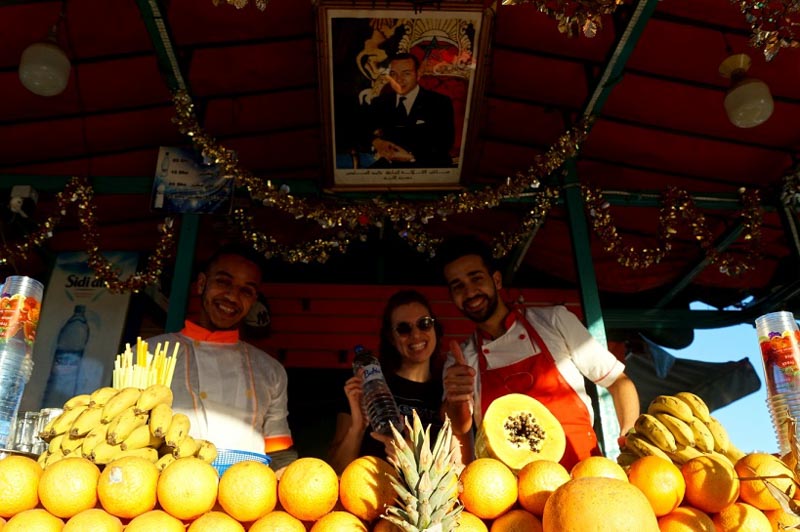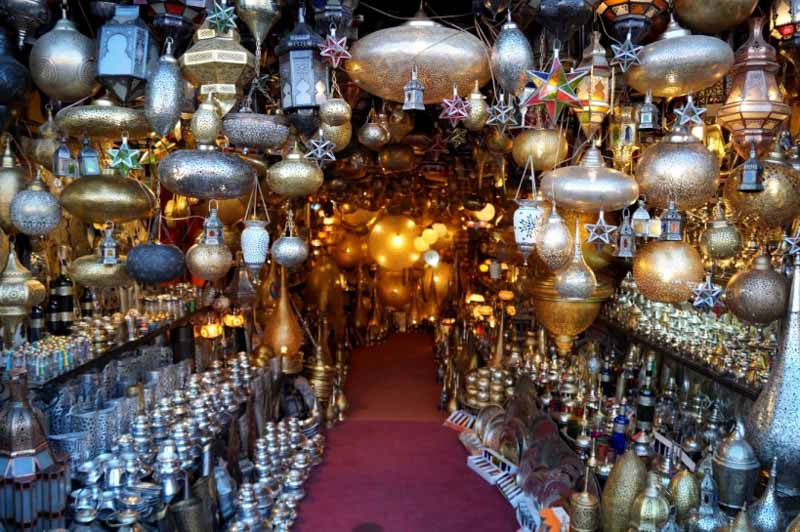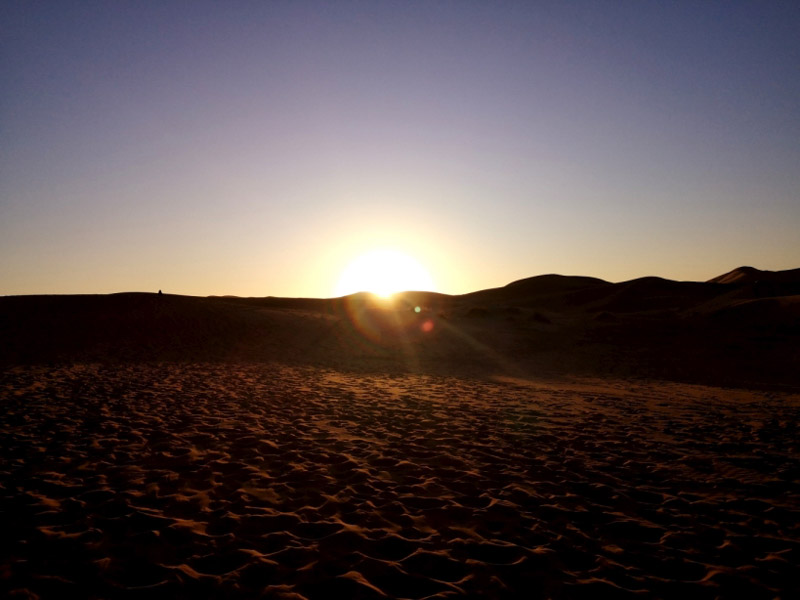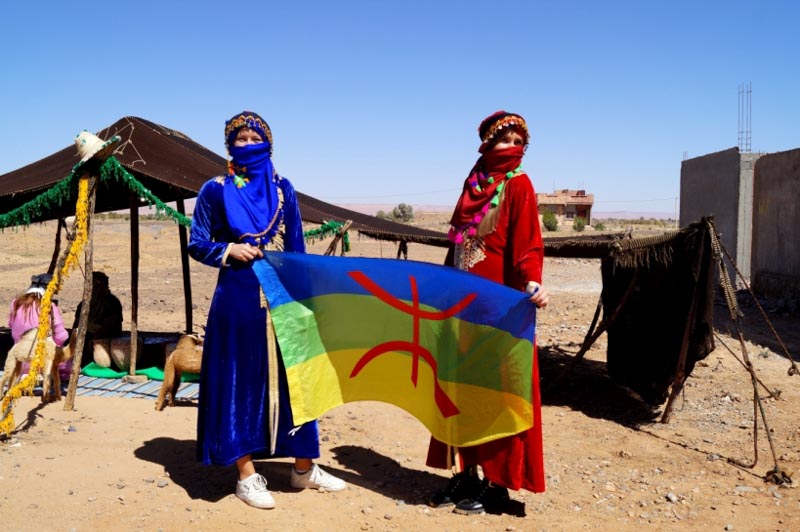The following blog has been written by Bahia Fox after her recent trip to Morocco with Studentfy. It includes her personal experience, recommendations and tips about Morocco. To read her blogs about other cities and countries she has been to check out her website, Mrs Fox on the Run.
Backstory
So here we are, three friends from Germany, Paula, Lisann and me (Bahia), that haven’t seen each other for a long time; one of us has been studying in Barcelona for the past six months and two others still in Germany.
We missed each other and it was time for a reunion. Since both the flights to and from Barcelona or Germany have unexpectedly been expensive for far too long, we got creative and decided to plan a trip to Morocco. This is a country that I, at least, have always been very interested in visiting for a long time but didn’t want to travel there alone.
Since all three of us are students, it should have been an affordable trip to Morocco, so that we could enjoy it and not being too concerned about the budget. Through Lisann, who is studying in Barcelona, we found a suitable offer for a student trip to Morocco: Studentfy’s trip to Morocco.
Studentfy’s Discover Morocco trip is a very affordable student trip to Morocco that everyone can join from anywhere in the world with a discount for the Studentfy card holders in Barcelona. This was a no-brainer for us, so we booked the 5-day tour to Morocco for the beginning of March 2020.
Arrival
I forced Paula to meet me “Bahia-standard” three hours before departure at the gate. I had never been so badly prepared for a trip as I was for this one, because I was in the middle of my bachelor thesis, my head was overloaded, but I could hardly wait for this well-deserved five-day trip to Morocco.
On route and shortly before approaching Marrakech, we filled out the forms for the Ministry of Health on the plane, which we later on handed over to the customs officials together with our passport (tip: always pack a pen, because they are never handed out in the plane).
Next to the stamp in our passports, the customs officials wrote an individual arrival number by hand, which was cross referenced with every hotel booking, so that your whole trip can be traced and verified.
At the airport, we withdrew cash, bought a SIM card and were picked up by a local driver, who took us to our hotel in Marrakech for the first evening before our Moroccan adventure started the next day.
The ride from the airport to the city center took about 15 minutes. We quickly brought our luggage to our room and started strolling for some first impressions through the famous Jama El f’na Market, which was overflowing with handicrafts, clothes, beautiful materials – and of course, not to forget, all kinds of delicious foods and sweets.
Marrakech is a beautiful combination of old, traditional and new Morocco. Its labyrinths of bazaars (so called “souks”) are surrounded by the old town ruins.
We ate our way through stands of various snacks and enjoyed the delicious freshly squeezed juices. At sunset, we made our way back to our hotel in order to rest for the coming days.
Day 2
The next morning at breakfast we finally met Lisann, who brought her dear friend Sara from Spain along. At about 08:30 that morning, we started our journey through the Atlas Mountains towards the Dades Canyon. We covered approximately 300 km that day, with a first stop in the heart of the Atlas Mountains.
At lunchtime, we arrived in the province and southern capital of Ouarzazate. Here we had lunch in a calm little restaurant enjoying a traditional dish: a vegetable tajine with couscous on the side. A tajine is a round, clay stew pot with a pointed lid with vegetables and all kinds of meat slowly to perfection in it.
With a stomach full of happiness, we walked strengthened to the UNSECO World Heritage Site Ksar Ait Ben-Haddou. The fortified city is at the foot of the High Atlas Mountain range, which often serves as an international film set, for example, for the film “Gladiator” or the series “Game of Thrones”. (Not that it deserves a judgment, I must confess that I might be one of the few people in the world who have never seen the “Game of Thrones”.)
Thanks to this trip, we got to know the Moroccan culture firsthand and hear related anecdotes, which are of great significance. In addition, we were introduced to the art of parchment paper burning.
A local resident showed us how he artistically burns whole landscapes on parchment paper using tea and other natural materials, thus making it permanent and visible forever, very interesting! The climb to the plateau was exhausting, but it was worth every step because of the incredible and breathtaking views that you get to see.
We spent the second night in the Dades valley. We made it just in time to watch the stunning sunset behind these magnificent mountains. The dinner at the Hotel Vieux Chateau was so incredibly delicious and prepared with so much love – definitely a culinary event not be missed, even if you only passing by for this incredible dinner!
For starter, there was delicious curry soup and for the main dish we were served again a suburb vegetable tajine with well marinated chicken, rice and couscous. We were in heaven!
At the end of the gorge, we joined our transport again and continue towards the Sahara Desert.
We stopped for lunch at a lovingly decorated small roadside restaurant along on the R702. While we waited for our meal – we again chose peppermint tea and a tajine.
For fun, Paula, Lisann and Sara got dressed in traditional Moroccan clothes by the locals and had their hands decorated with henna to highlight the occasion. Now only a few more kilometers separated us from the Sahara!
Book Your Morocco Trip Now
Book your ticket and start discovering Morocco now.
We have an amazing 5-day trip to Morocco available every day of the year.
Download the Studentfy app, pick any date you want and book your ticket in a few seconds.
Day 3
At around 09:00 in the morning of the third day, after an equally tasty breakfast, we headed back on the road towards the small village of Merzouga on the Sahara’s edge and close the border to Algeria, which was our final destination of the day. We covered about 280 km which doesn’t sound like much, but it took us about 6 hours.
On the way there, our first stop was the oasis town of Tinghir. This town is blessed with two palm tree oases, which are rich with dates, figs, olives and many other delicacies.
We stopped shortly before the Todra Gorge and continued on foot through this breathtaking gorge with its steep rockfaces, which are up to 300 meters high and attract numerous climbers. Respect! I would probably not dare to go up there.
Millions of years ago, the Oued Todra (directly translated meaning “river”) has cut an impressive path through the mountains towards the south of the country here. Today the river is only a mere stream.
On the third night, we were supposed to sleep in the middle of the Sahara Desert in a beautiful tent camp. Because I had already been to the Tunisian-Libyan part of the Sahara for 14 days in 2012 and I knew what we were roughly in for, I was quite excited to share this experience with my friends.
The starry sky, the sunset and sunrise were simply something out of this world that I will never forget. We finally arrived in the small village of Merzouga, which also served as backdrops in some movies.
Our desert tent camp, which I already mentioned previously, was located a few kilometers in the desert. In order to get there, camels were saddled up for us to ride through the desert. ”Woohooo! Moroccan camel ride!“.
However, Paula and I decided against riding on the camels and opted for walking barefoot through the warm Saharan desert sand. if you don’t start dreaming now, you have unfortunately never been allowed to do that before and cannot understand how beautiful it is to walk barefoot through warm sand!
While everyone else was stuck on their camels, we ran through the soft sand like little children and were able to take great photos. After the long car ride, the workout was also a welcome change and really did us good!
We arrived at the Sara Dune (you’ll find out in a moment why it carries that name). You can go sandboarding if you want to or you can just enjoy the evening sun, or both. Here we stayed until the sunset – what a wonderful experience it was!
Two of the Berbers, one of them whose name was Moe, who has lived and grew up in this part of the Sahara joined us and laughingly answered all our thousands of questions about their lifestyle, their everyday life and their aspirations.
We talked in a mixture of English, Spanish and French, but it worked. As it turned out, the two speak eight languages pretty much fluently! But there was one language in particular that Moe speaks fluently: the Language of Love. And not before long, Sara gets a – admittedly not quite seriously-meant (hopefully) – marriage proposal!
As a token of Moe’s love, and because the sand dune at whose edge we sat was too small to be already named, he spontaneously names it after her: “Sara Dune”.
After this auspicious occasion, the chatting and laughing, we sat there for a few more hours, reminiscing about everyday life, listening to stories from our two friends and enjoying the setting sun. Shortly before darkness, we left and made our way to the tent camp for the last kilometers.
This camp exceeded all our expectations by far! Really! We were welcomed with freshly made peppermint tea around a warm campfire, which was set up in the middle of the tent camp.
The night was getting quite chilly. As soon as the sun goes down in the desert, the temperatures get close to the freezing point. In our tents we first put on something warmer, warmed ourselves at the campfire and waited for dinner, which was served in a big tent.
After dinner, we all gathered around the campfire, huddled up in thick woolen blankets. The Berbers, who led us through the desert today, organized a drumming session for us and let us participate in traditional dances, which later included more other traditional instrument.
What started off more like a noise-jungle at the beginning quickly turned into “We will rock you” and “Don’t worry be happy”; So we sat together all evening until late night, dancing, learning the different instruments and enjoying the small desert festivity.
Day 4
We set the alarm clock for 06:30 the next morning in order to enjoy the desert sunrise with its warming rays, with coffee in hand. We were dog-tired from the very short night (it was freeeeeezing; I really advise bringing scarfs and hoodies), but because of getting up early, we were rewarded with this magnificence sunrise, which left us speechless.
After we found our words again, we packed our bags and made our way back to Marrakech. From the desert all the way back to Marrakech, it was about 500 km long and thanks to small food breaks, the 11-hour drive was finally conquered.
The final day
Tired but happy and full of impressions, we arrived at our hotel late that evening. In order to make this already-perfect trip even better, we decided to go into town and spend the last hours celebrating and reminiscing together in the tiny restaurant Café Des Épices with freshly squeezed juices and uber-delicious food. We all agreed what a wonderful trip it was!
The next morning Lisann and Sara had to leave early for the airport; so we already said our goodbyes the evening before.
Thank you, girls, for the great time and thank you, Studentfy and Morocco Trips, for making this student trip from Spain and Germany to Morocco possible! It really was the ideal trip to Morocco for students.
General recommendations
In my opinion, spring is the best time to visit Morocco because the days are warm and comforable but the nights get too cold especially in the desert.
Speaking of cold nights – here are a few things to know before going to Morocco:
The nights in the desert get cold
In spring, or at least in March, the nights are very cold. Especially in the desert. This means that you should definitely pack a beanie, a warm head cover or a hoodie to keep warm. Spoiler Alert: All our mothers were right when they told us during our childhood: “Put on a beanie! Most of the body heat is lost through the head.”
Respect the local traditions
Most people in Morocco are Muslims. This means that as guests in their country, we must respect their customs, beliefs, and their traditions. So, when you are packing for such this a trip, you should think about what to wear in Morocco in order to respect these customs especially when you are leaving the big cities, as the more rural setting is areas are traditionally more grounded.
t least, your shoulders and knees should be covered. Regardless of whether this is the current fashion in other countries, cropped or backless tops are also rather uncool. It’s always best to pack a scarf or cloth that you can wear around your shoulders or waist and over your head when visiting holy sites. However, it is not necessary to wear a hijab in public.
The local money is easy to understand
In Morocco, you pay with Moroccan Dirham (MAD). The exchange rate when we visited was about 10 MAD for 1€ which makes the conversion really easy. ATMs can be found directly at the airport, in all bigger cities and some villages. Paying with a credit card is possible almost everywhere.
Tipping isn’t required
Generally, tips are not accepted (maybe if you are Moroccan and reading this can explain why?). For this reason, I quickly stopped it in order not to offend anyone. If you insist on tipping anyway, give it with your right hand, because the left hand is considered insulting in Arab countries. In cities, it’s more forgiving but not so much in some villages.
Telekom Morocco has great SIM cards
I bought a Moroccan SIM card with 5GB data at the airport for about 8€. Telekom Morocco has an excellent network coverage throughout the country.
Morocco’s History
Morocco only gained independence from France in 1956 and is now a kingdom. Everywhere in hotels, shops and markets you can find the portrait of King Mohammed VI, who has been in power since 1999.
The Kingdom of Morocco is located in the northwestern tip of Africa and only a few kilometers across the Mediterranean Sea from the Spanish mainland via the Strait of Gibraltar. With a population of 32.6 million inhabitants, which is less than half of Germany’s population, it is about 1.2 times larger than Germany with an area of 447,000 square kilometers. Morocco’s capital is the coastal city of Rabat.
Although Arabic is the most common language, French is widely spoken due to its colonial past. In touristic settings, you can also find that a lot of Spanish is being spoken, which may be due to the proximity to the Spanish mainland.
As in all Arabic countries, bargaining is gladly accepted and becomes a real sport if you get involved. The final price is usually 50% cheaper than the original price, unless fixed prices are given.
Entering the country from Europe is relatively unproblematic. With a passport valid for at least six months, you can stay in the country for up to 90 days without a visa (you can see if you need a visa to visit Morocco or not here).
Safety
People have asked me: “Is it safe to visit Morocco … as a European woman?” I have to admit that I probably wouldn’t necessarily do this trip alone, but that’s only me. We never felt uncomfortable at any time, not even as a group of four young women.
During the journey we were often surrounded by other students, local drivers and tour guides and really never alone. As in other Arab countries, of course you often dragged into the competition between passionate vendors at markets, but never touched or held onto.
The Moroccans are much more charming and humorous to me as one might expect. It also struck me positively that there is a lot less littering that I observed in other countries.
Book a Trip to Morocco
You can read all about our trip to Morocco on our Morocco Trip page.
How useful was this post?
Click on a star to rate it!
Average rating 4.8 / 5. Vote count: 90
No votes so far! Be the first to rate this post.
We are sorry that this post was not useful for you!
Let us improve this post!
Tell us how we can improve this post?















